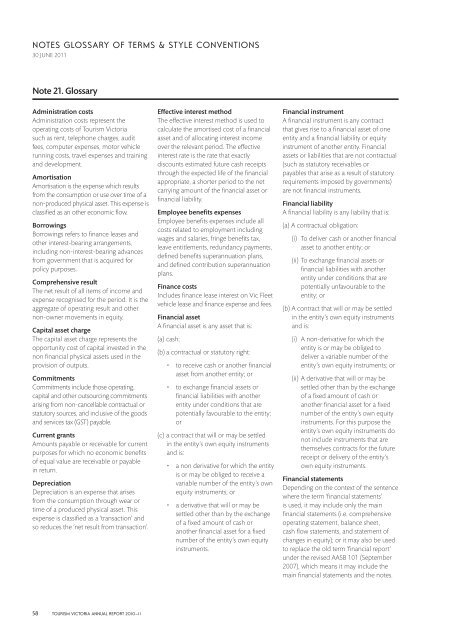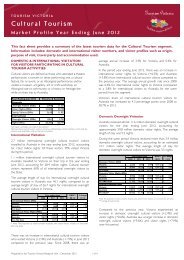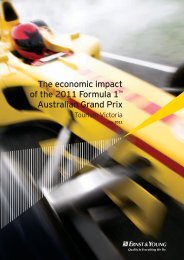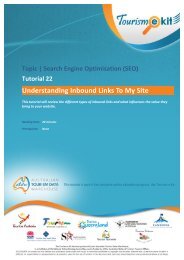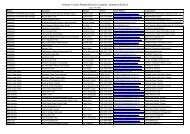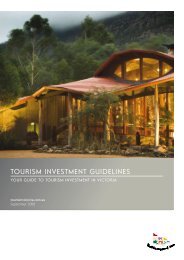Annual Report 2010–2011, Part 2: Financial (1.8 ... - Tourism Victoria
Annual Report 2010–2011, Part 2: Financial (1.8 ... - Tourism Victoria
Annual Report 2010–2011, Part 2: Financial (1.8 ... - Tourism Victoria
Create successful ePaper yourself
Turn your PDF publications into a flip-book with our unique Google optimized e-Paper software.
NOTES GLOSSARY OF TERMS & STYLE CONVENTIONS<br />
30 JUNE 2011<br />
Note 21. Glossary<br />
Administration costs<br />
Administration costs represent the<br />
operating costs of <strong>Tourism</strong> <strong>Victoria</strong><br />
such as rent, telephone charges, audit<br />
fees, computer expenses, motor vehicle<br />
running costs, travel expenses and training<br />
and development.<br />
Amortisation<br />
Amortisation is the expense which results<br />
from the consumption or use over time of a<br />
non-produced physical asset. This expense is<br />
classified as an other economic flow.<br />
Borrowings<br />
Borrowings refers to finance leases and<br />
other interest-bearing arrangements,<br />
including non-interest-bearing advances<br />
from government that is acquired for<br />
policy purposes.<br />
Comprehensive result<br />
The net result of all items of income and<br />
expense recognised for the period. It is the<br />
aggregate of operating result and other<br />
non-owner movements in equity.<br />
Capital asset charge<br />
The capital asset charge represents the<br />
opportunity cost of capital invested in the<br />
non financial physical assets used in the<br />
provision of outputs.<br />
Commitments<br />
Commitments include those operating,<br />
capital and other outsourcing commitments<br />
arising from non-cancellable contractual or<br />
statutory sources, and inclusive of the goods<br />
and services tax (GST) payable.<br />
Current grants<br />
Amounts payable or receivable for current<br />
purposes for which no economic benefits<br />
of equal value are receivable or payable<br />
in return.<br />
Depreciation<br />
Depreciation is an expense that arises<br />
from the consumption through wear or<br />
time of a produced physical asset. This<br />
expense is classified as a ‘transaction’ and<br />
so reduces the ‘net result from transaction’.<br />
Effective interest method<br />
The effective interest method is used to<br />
calculate the amortised cost of a financial<br />
asset and of allocating interest income<br />
over the relevant period. The effective<br />
interest rate is the rate that exactly<br />
discounts estimated future cash receipts<br />
through the expected life of the financial<br />
appropriate, a shorter period to the net<br />
carrying amount of the financial asset or<br />
financial liability.<br />
Employee benefits expenses<br />
Employee benefits expenses include all<br />
costs related to employment including<br />
wages and salaries, fringe benefits tax,<br />
leave entitlements, redundancy payments,<br />
defined benefits superannuation plans,<br />
and defined contribution superannuation<br />
plans.<br />
Finance costs<br />
Includes finance lease interest on Vic Fleet<br />
vehicle lease and finance expense and fees.<br />
<strong>Financial</strong> asset<br />
A financial asset is any asset that is:<br />
(a) cash;<br />
(b) a contractual or statutory right:<br />
• to receive cash or another financial<br />
asset from another entity; or<br />
• to exchange financial assets or<br />
financial liabilities with another<br />
entity under conditions that are<br />
potentially favourable to the entity;<br />
or<br />
(c) a contract that will or may be settled<br />
in the entity’s own equity instruments<br />
and is:<br />
• a non derivative for which the entity<br />
is or may be obliged to receive a<br />
variable number of the entity’s own<br />
equity instruments; or<br />
• a derivative that will or may be<br />
settled other than by the exchange<br />
of a fixed amount of cash or<br />
another financial asset for a fixed<br />
number of the entity’s own equity<br />
instruments.<br />
<strong>Financial</strong> instrument<br />
A financial instrument is any contract<br />
that gives rise to a financial asset of one<br />
entity and a financial liability or equity<br />
instrument of another entity. <strong>Financial</strong><br />
assets or liabilities that are not contractual<br />
(such as statutory receivables or<br />
payables that arise as a result of statutory<br />
requirements imposed by governments)<br />
are not financial instruments.<br />
<strong>Financial</strong> liability<br />
A financial liability is any liability that is:<br />
(a) A contractual obligation:<br />
(i) To deliver cash or another financial<br />
asset to another entity; or<br />
(ii) To exchange financial assets or<br />
financial liabilities with another<br />
entity under conditions that are<br />
potentially unfavourable to the<br />
entity; or<br />
(b) A contract that will or may be settled<br />
in the entity’s own equity instruments<br />
and is:<br />
(i) A non-derivative for which the<br />
entity is or may be obliged to<br />
deliver a variable number of the<br />
entity’s own equity instruments; or<br />
(ii) A derivative that will or may be<br />
settled other than by the exchange<br />
of a fixed amount of cash or<br />
another financial asset for a fixed<br />
number of the entity’s own equity<br />
instruments. For this purpose the<br />
entity’s own equity instruments do<br />
not include instruments that are<br />
themselves contracts for the future<br />
receipt or delivery of the entity’s<br />
own equity instruments.<br />
<strong>Financial</strong> statements<br />
Depending on the context of the sentence<br />
where the term ‘financial statements’<br />
is used, it may include only the main<br />
financial statements (i.e. comprehensive<br />
operating statement, balance sheet,<br />
cash flow statements, and statement of<br />
changes in equity); or it may also be used<br />
to replace the old term ‘financial report’<br />
under the revised AASB 101 (September<br />
2007), which means it may include the<br />
main financial statements and the notes.<br />
58 TOURISM VICTORIA ANNUAL REPORT 2010–11


